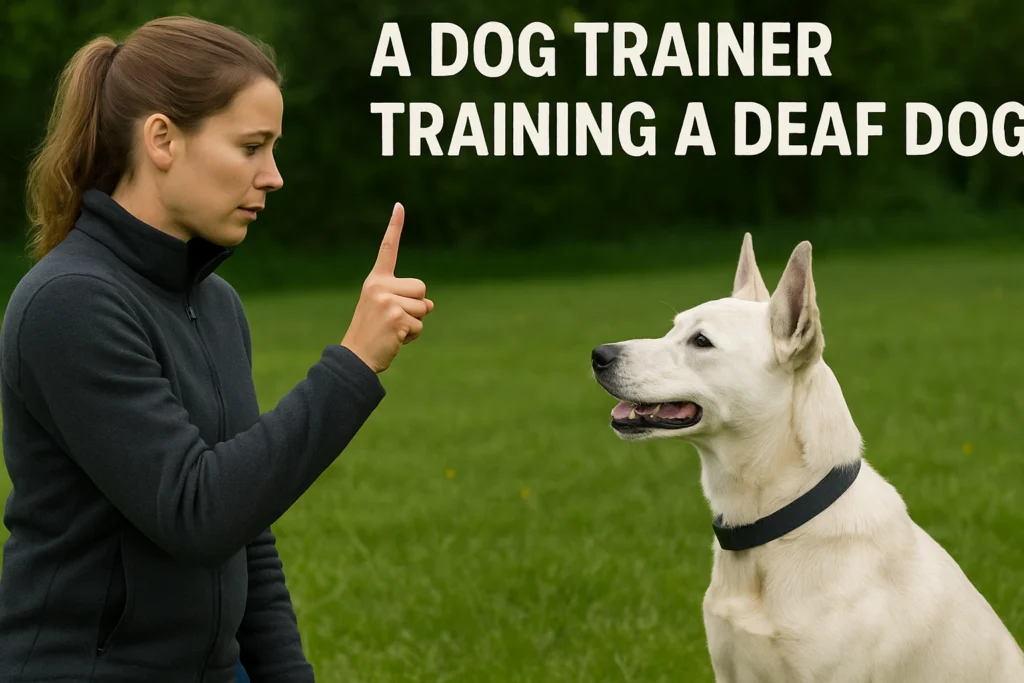Deafness in dogs is more common than many people realize. It can occur from birth (congenital deafness), develop due to old age, or result from trauma, illness, or prolonged exposure to loud noises. Some breeds, such as Dalmatians, Australian Shepherds, and Boston Terriers, are genetically predisposed to deafness due to the presence of a gene associated with white pigmentation. This doesn’t make them any less lovable or capable—it simply means they require a slightly different approach to communication and training.
When you train a deaf dog, you’re essentially learning a new language together. Instead of relying on auditory cues, you use visual signals, vibrations, and touch. Just like humans who are deaf can live full and meaningful lives, dogs with hearing loss can thrive with the right support. It’s all about meeting them where they are and building a bond based on mutual understanding, consistency, and trust.
This shift in communication may seem daunting at first, but it opens up a world of possibilities. Deaf dogs are incredibly perceptive—they learn to pick up on subtle body language, facial expressions, and even vibrations through the floor. They don’t hear your words, but they see your love, your consistency, and your leadership.
Why Training a Deaf Dog is Unique
Training any dog requires patience and structure, but with a deaf dog, the need for creativity and non-verbal communication is amplified. Since you can’t call them or use verbal commands, every instruction must be visual, tactile, or environmental. This difference doesn’t mean it’s harder—it’s just different.
Many owners of deaf dogs find their pets even more attentive during training sessions because there’s less background noise to distract them. They’re more in tune with visual cues and often form an intense bond with their human because their primary sense of guidance is sight. But the challenge lies in consistency. You can’t shout across the park to call them back. Instead, you need to teach hand signals, use vibrating collars responsibly, or train them to respond to flashing lights.
It also requires the trainer (you) to be very mindful of your actions. A shrug, a smile, a furrowed brow—all these become crucial elements of communication. Training a deaf dog is less about commanding and more about collaborating. And that’s a beautiful thing.
Essential Gear for Safety and Communication
In addition to training tools, here are must-have items for deaf dog owners:
- ID Tags: Clearly label your dog as deaf on their collar.
- Harness with Labels: “I’m Deaf” harnesses can alert others.
- LED Collar: Increases visibility at night and during walks.
- Leash with Pouch: Easy treat access while training.
- Treat Dispenser Toys: Keeps them mentally engaged between training.
Effective Strategies For Training Deaf Dog
1. Getting a Professional Diagnosis
While DIY observations can be helpful, a professional diagnosis ensures you fully understand your dog’s condition. Vets can conduct a BAER test (Brainstem Auditory Evoked Response), the most accurate way to measure hearing. This test records electrical activity in the brain in response to sound stimulation, providing clear evidence of hearing capacity in one or both ears.
Getting a diagnosis also helps you understand whether the deafness is partial or complete, temporary or permanent. This knowledge gives you a stronger foundation when creating a training plan tailored to your dog’s specific needs. Plus, early diagnosis can help prevent complications or address underlying health issues before they worsen.
2. Preparing to Train a Deaf Dog
When it comes to training deaf dogs, patience isn’t just a virtue—it’s a requirement. Progress might feel slow at times, especially if you’re new to working with a dog who can’t hear your voice. But every small success counts. Deaf dogs learn just as well as hearing dogs when given the right structure, love, and motivation.
Consistency is also your best friend. Because your dog can’t rely on tonal changes or vocal corrections, your actions must be reliable and repetitive.
Choose specific hand signals for commands and stick with them. Don’t switch up gestures on a whim. Imagine trying to learn sign language if the signs changed every day—it’s confusing for the learner. Your dog feels the same way.
Reinforce positive behaviors every single time, especially in the beginning. This builds a strong association between the visual signal and the action you’re asking for. It also builds trust. Your dog starts to understand what you expect—and how to succeed. That confidence is key in any training journey.
3. Creating a Distraction-Free Environment
A quiet, safe environment makes training easier for any dog, but it’s essential for a deaf dog. Start indoors, in a room with minimal visual distractions. Turn off the TV, avoid high foot traffic, and keep other pets at bay while training. Your goal is to create a learning zone where your dog can focus only on you.
Once your dog masters the basics in a calm environment, gradually introduce distractions. This helps them generalize commands to different settings. Training in a park, near other dogs, or around new smells is the ultimate test—but don’t rush it. Every dog learns at their own pace.
Use baby gates, leashes, or training pens to maintain a controlled space. It’s not about restriction—it’s about setting your dog up for success. The fewer the distractions, the faster the learning curve.
4. Building Trust Through Body Language
With deaf dogs, your body becomes your voice. The way you move, your posture, and your facial expressions carry powerful messages. Are you relaxed? Are you animated when offering praise? Are you confident in your gestures? These cues are vital.
Start by using eye contact and touch to get your dog’s attention. A gentle tap on the shoulder or a stomp on the floor (to create a vibration) can work wonders. Then use exaggerated gestures and smiles to show encouragement or approval. Avoid sudden or aggressive movements, as these can startle a deaf dog more than a hearing one.
Trust doesn’t happen overnight. But every calm interaction, every consistent cue, every reward builds a bridge. Eventually, your dog will look to you for direction—not because they’re scared of missing a command, but because they feel safe, respected, and understood.
5. Using Hand Signals Instead of Verbal Commands
Training a deaf dog starts with replacing spoken commands with visual ones—specifically, hand signals for deaf dogs. These signals can be custom-made or based on American Sign Language for dogs, but what matters most is consistency. If “sit” is represented by a closed fist moving downwards, always use that same gesture. Changing it up will only confuse your dog.
The beauty of hand signals is that they’re highly effective and allow for clear, unambiguous communication. You’re essentially teaching your dog a visual language for deaf pets. The good news? Dogs are amazing visual learners. With repetition and positive reinforcement, they begin to associate specific gestures with actions—and rewards.
Start with the basics:
- How to teach a deaf dog to sit: Palm facing up, lifting your hand.
- Stay: Open palm facing your dog, like a “stop” gesture.
- Come: Arm outstretched, then motioning inward.
- Down: Finger pointing to the ground.
- Good job/Yes: A thumbs-up works perfectly.
It’s helpful to pair these gestures with treats and clear body language. Smile. Nod. Make your approval obvious. Over time, your dog learns to respond to these signals just as reliably as they would to verbal commands.
6. Visual and Vibrational Cues
Since sound is off the table, you’ll need to get creative with how to get a deaf dog’s attention. Visual and vibrational cues are game changers.
Visual cues can be as simple as turning a light on and off to signal a transition, or waving your hand to catch attention. Dogs quickly learn to associate these flashes or gestures with the beginning of a command.
Vibrational cues are often misunderstood. We’re not talking about shock collars here—those are cruel and unnecessary. Instead, many trainers use vibrating collars for deaf dogs that gently buzz to signal a command or catch attention. These devices are not for punishment—they’re a form of communication. Think of them like a tap on the shoulder when someone isn’t facing you.
Floor vibrations can also be used. Some dogs feel it when you stomp lightly on the ground, which is another way to get their focus. This method works well in home settings and is especially effective with puppies or dogs sensitive to floor vibrations.
7. The Role of Treats and Positive Reinforcement
If you want your deaf dog to love training, best treats for training deaf dogs are the way to go. Positive reinforcement is a cornerstone of modern dog training and is even more crucial for deaf dogs, who rely on clear associations between action and reward.
Always have a pouch of tasty treats ready. When your dog performs the correct action after a hand signal or cue, immediately give a treat and flash a happy facial expression or thumbs-up. Timing is everything. The reward should come the moment the behavior occurs so your dog understands what earned the treat.
Don’t just stop at food, though. Use other forms of positive reinforcement too:
- Belly rubs or ear scratches
- Playtime with a favorite toy
- Praise via enthusiastic gestures
- Petting or massage
Remember, deaf dogs are often more tuned into their environment visually and emotionally. Your energy, posture, and enthusiasm make a big difference. Celebrate their wins. Make training feel like a game. That emotional connection is what transforms training from a chore into bonding time.
8. Teaching Recall with Visual Signals
Recall—getting your dog to come when called—is one of the most important commands, especially for deaf dogs who can’t hear you shouting across the yard. It’s also one of the trickiest.
Start indoors or in a fenced area. Use a consistent visual cue for “come”—such as extending your arm and pulling it back to your chest. Whenever your dog comes to you, shower them with praise, treats, and affection. Practice in short bursts to keep them excited and engaged.
You can use tools like vibrating collars or flashing lights to get their attention first, followed by the visual cue. This way, even if they’re not looking at you, they can feel or see the signal to check in with you.
Never punish your dog if they don’t come right away. That creates a negative association. Always make returning to you the most rewarding and positive option. It takes time, especially in distracting environments, but consistency wins.
9. Clicker Training Alternatives
Traditional clicker training uses a small device that makes a distinct “click” sound to mark desired behaviors, followed by a reward. Obviously, this doesn’t work for deaf dogs. But the concept—marking a correct behavior with a consistent signal—still applies.
You can use:
Visual markers for deaf dog training:
- A hand flash or flick
- A thumbs-up as a visual marker
- A light pulse (like from a small flashlight)
- A gentle tap on their back or shoulder
The idea is to replace the “click” with something the dog can perceive instantly. Combine this with a reward, and your dog will quickly learn that the signal means “Yes! That’s what I wanted you to do!”
This visual or tactile marker bridges the time gap between behavior and reward, making your training much more effective.
10. Using Light and Vibrations for Directional Guidance
Advanced training goes beyond commands like “sit” and “stay.” You can use environmental cues to guide a deaf dog around the house or yard. For instance, flashing a porch light can signal that it’s time to come inside. Using a vibrating collar at the dog park can mean “look at me” or “check in.”
You can even set up lights in different parts of the house to signal different routines—like mealtime, bedtime, or walk time. Dogs are incredibly pattern-oriented and pick up on these cues quickly.
Directional training can also help with off-leash control. Pointing in a direction followed by a signal or hand gesture can help guide your dog safely in open areas. Combined with consistent positive reinforcement, these cues become second nature over time.
Tools and Equipment for Training Deaf Dogs
Vibrating Collars: Myths and Facts
There’s a lot of confusion about vibrating collars. Let’s clear it up: vibrating is not the same as shocking. A how to use vibrating collars for deaf dogs provides a gentle buzz that can be used to get your dog’s attention—not to punish or startle them.
The key is proper introduction and conditioning. Start by pairing the vibration with something positive. Press the button, then offer a treat. Your dog will learn to associate the vibration with something good and look to you for the next cue. Over time, the vibration becomes a signal to “check-in” or get ready for a command.
Make sure to:
- Use a high-quality, adjustable collar
- Test different vibration levels for comfort
- Never use it as a disciplinary tool
Used correctly, vibrating collars are incredibly effective and humane for communicating with deaf dogs, especially in outdoor environments.
Flashlights and Laser Pointers
Visual tools like flashlights and laser pointers can serve as cues or attention-getters, especially in low-light conditions. Flashing a light on the ground or wall can be used to call your dog to you or redirect their attention.
Important: Never shine a laser directly into your dog’s eyes. Also, be cautious—some dogs can become obsessed with chasing lights, leading to compulsive behavior. Use these tools sparingly and purposefully, not as toys.
Flashlights can also help during nighttime walks. A quick on-off signal can mean “look at me” or “return.” Consistency is, again, the secret sauce.
Overcoming Frustration and Miscommunication
Training any dog can test your patience, but training a deaf dog brings unique frustrations. Sometimes, your dog simply won’t see the hand signal. Other times, they’ll be so focused on something else—another dog, a squirrel, a toy—that your visual cue is completely ignored. And because verbal corrections aren’t an option, you might feel helpless or stuck.
But here’s the truth: frustration is normal. The key is not letting it control your training sessions. Deaf dogs aren’t being stubborn or disobedient—they just require clearer communication methods for deaf dogs. If they’re not responding, ask yourself:
- Was the signal consistent?
- Were they distracted?
- Did they actually see the cue?
- Was there a reward worth working for?
Always reset calmly. Training through frustration only damages trust. Keep sessions short—five to ten minutes at a time—and always end on a positive note, even if it’s just a successful “sit.”
Celebrate every win, no matter how small. Remember, your energy speaks louder than any words ever could to a deaf dog.
Managing Anxiety and Fear in Deaf Dogs
Deaf dogs are more prone to anxiety because the world can be startling when you can’t hear it coming. They can be jumpy when touched unexpectedly, and they may become reactive in unfamiliar environments. This sensitivity can make training—and day-to-day life—challenging.
Start by working on desensitization techniques for deaf dogs. Let your dog get used to gentle touches from behind by rewarding calm reactions. Pair every touch with a treat. Over time, they’ll start to expect good things from sudden contact.
Another key is predictability. Deaf dogs thrive on routine. Create a structured day-to-day schedule for meals, walks, and training. The more predictable their world, the less anxious they become.
For dogs with severe anxiety, tools like calming wraps for anxious dogs or professional behaviorists may be necessary. Don’t hesitate to reach out for help if your dog’s fear is affecting their quality of life.
Training should never feel like punishment or fear-based correction. Make it a safe, enjoyable experience that builds your dog’s confidence.
Handling Outdoor and Off-Leash Situations
Outdoor training is where things get real. It’s one thing to have perfect hand-signal obedience in your kitchen. It’s another to get your dog to respond when a rabbit darts across a field.
This is where leash training techniques for deaf dogs become essential. Use long training leads in open areas so your dog has room to explore but is still under control. Practice recall often. Use visual or vibrational cues to get their attention, then reward like crazy when they come to you.
Avoid off-leash play unless you’re in a secure, fenced area. Even a well-trained deaf dog can’t hear oncoming traffic, bikes, or danger. Use visual markers in the yard (flags, cones) so your dog knows the limits of their play space.
And don’t forget to inform others. If someone’s approaching your dog, let them know they’re deaf. You can even have a “Deaf Dog” identification tags on their leash or harness so passersby know to approach gently.
Socialization Strategies
Interacting with Other Dogs
Deaf dogs, like hearing dogs, need proper socialization for deaf puppies. But because they miss out on auditory cues like growls or barks, they can sometimes misread the room—literally.
Careful introduction is key. Start with calm, well-mannered dogs in a controlled environment. Watch closely for body language from both dogs. If either one seems stiff, tense, or overly excited, it’s time to step back.
Use visual cues to guide your deaf dog. You might need to interrupt play occasionally to ensure they’re not crossing another dog’s boundaries. Some dogs tolerate more roughhousing than others, and a deaf dog might not realize when they’re pushing the limit.
Playdates with other deaf dogs—or dogs used to deaf companions—can be especially rewarding. But even if your dog’s playmates all have sharp hearing, you can still ensure safe and fun interaction with proper supervision and regular training check-ins.
Helping Others Understand Your Dog’s Needs
Many people don’t know how to act around a deaf dog. They might reach out suddenly, shout commands, or assume the dog is disobedient when they don’t respond. Educating those around you is part of your responsibility as a deaf dog owner.
Equip your dog with clear gear—a harness or leash that reads “I’m Deaf” can prevent misunderstandings. Teach family and friends to use your dog’s established hand signals. And if children are around, show them how to safely approach a deaf dog.
Also, keep your vet in the loop. Let them know about your dog’s deafness ahead of time. Some clinics offer special handling techniques for deaf animals, including signaling methods during exams and procedures.
The more people understand your dog’s needs, the easier it is to create a supportive, inclusive environment.
Common Causes of Canine Deafness
Understanding what caused your dog’s deafness can be helpful in training. Deafness can be congenital, often present in breeds with specific genetic traits.
If your dog is born deaf, you may notice signs from an early age: they might not respond to their name, loud noises, or verbal corrections. On the other hand, acquired deafness happens later in life and can result from:
- Chronic ear infections
- Trauma to the head
- Certain ototoxic medications
- Aging (presbycusis)
- Loud environments (e.g., fireworks, gunshots, loud music)
Knowing the cause can inform how you approach training. For instance, a senior dog losing its hearing may already know verbal commands—you’ll need to transition those into visual ones. Meanwhile, a puppy born deaf might start from scratch but could also be more adaptable.
Additionally, some deaf dogs might retain the ability to hear certain frequencies, so they may respond to loud claps or high-pitched sounds. However, you should never rely on inconsistent hearing ability as the primary method of communication. Always assume they hear nothing and use visual or tactile cues as your base.
How to Tell if a Dog is Deaf
Sometimes, it’s hard to tell if a dog is fully deaf or just ignoring you. Here are common signs that might indicate deafness:
- Lack of response to sounds like doorbells, squeaky toys, or your voice
- Startling easily when approached from behind
- Sleeping very deeply and not waking up to noises
- Not responding to their name or commands unless they see you
- Noticing body vibrations before reacting
You can also try some home tests. Clap your hands behind the dog when they’re not looking, or drop a loud object on the floor from a distance. If they don’t flinch or react, it’s time for a professional evaluation.
inal Thoughts on Training Deaf Dogs
Training a deaf dog is a journey filled with both challenges and triumphs. While the absence of sound creates a different communication landscape, it doesn’t hinder the potential for deep, meaningful connection. In fact, it often enhances it. Through eye contact, body language, hand signals, and trust, you build a relationship based on mutual respect and understanding.
The keys to success are patience, consistency, and creativity. Whether you’re working with a deaf puppy or an older dog who’s lost their hearing, the fundamentals remain the same: create clear signals, offer rewards, and maintain structure. Embrace tools like vibrating collars and visual cues, and never underestimate the power of positive reinforcement.
Remember, your dog doesn’t need to hear your voice to feel your love. They read your movements, your energy, and your presence. And once that trust is established, deaf dogs are some of the most attentive, loyal, and joyful companions you’ll ever meet.
If you’re on the fence about adopting or training a deaf dog, take the leap. You’ll gain not just a pet, but a new way of seeing the world—through patience, presence, and the kind of connection that transcends sound.
FAQs
Can a deaf dog live a normal life?
Absolutely. Deaf dogs can live full, happy, and active lives. They might need different training methods and more structured routines, but they can run, play, learn commands, and bond deeply with their humans just like any hearing dog.
What are the best breeds for deaf dog training?
No breed is inherently better or worse at adapting to deafness, but breeds known for intelligence and focus—like Border Collies, Poodles, and German Shepherds—often pick up hand signals quickly. That said, every dog is unique, and deafness is common in breeds like Dalmatians, Bull Terriers, and Boxers.
Are vibrating collars safe for deaf dogs?
Yes, when used correctly. Vibrating collars should never be used as punishment. Instead, they’re gentle tools to get a dog’s attention or signal a command. Always introduce them gradually and pair the vibration with a positive experience like a treat or playtime.
How do I teach a deaf dog to stop barking?
Teaching a deaf dog not to bark excessively requires consistent redirection and rewards. Use hand signals to indicate “quiet” and reward the desired behavior. If barking happens when the dog is startled or seeking attention, teach alternative ways to communicate like bringing a toy or using eye contact.
Can old dogs who lose hearing be trained effectively?
Definitely. Senior dogs can learn new tricks, especially when you transition their known verbal commands into hand signals. It may take a bit more patience, but older dogs often enjoy the mental stimulation and one-on-one attention that training provides.










![Can Dogs Eat Blood? 7 Side Effects [Expert Opinion]](https://petskor.com/wp-content/uploads/2022/04/Webp.net-resizeimage-12.jpg)
